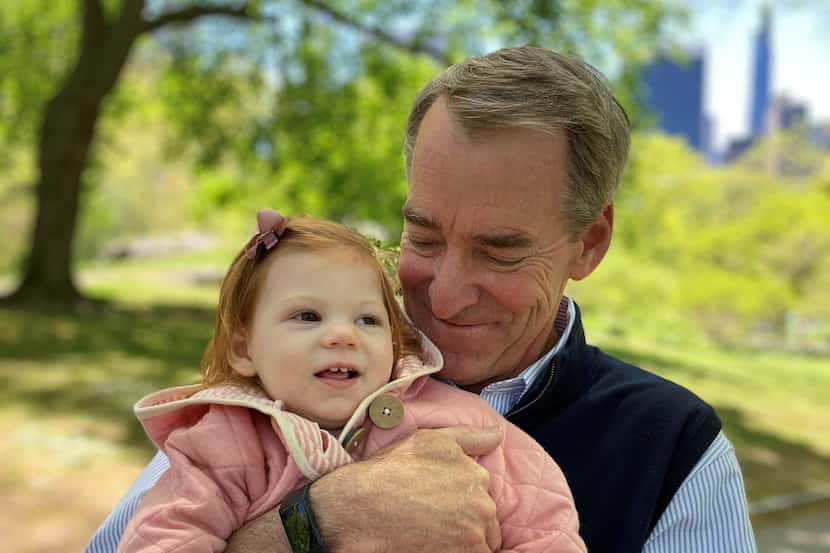Former American Airlines chief Tom Horton watched from his second home in New York in March 2020 as the aviation world ground to a near-halt when the emerging coronavirus spread from Asia to the United States and across the globe.
Among Horton’s guests were his son Zach, Zach’s wife Courtney and their newborn daughter, Gianna. But as the pandemic wore on and the aviation industry struggled to find its footing, the Hortons were distracted by Gianna’s early-life progress.
“It was evident to all of us that she was just sort of missing critical milestones,” said Horton, whose primary residence is in North Texas. “She doesn’t scoot around and crawl, and she’s nonverbal but very happy and engaged with everyone that she’s around.”
It was those early pandemic months, isolated from much of the world, that would eventually put Horton and his tiny granddaughter front and center in an emerging mysterious genetic condition known as FOXG1 syndrome that may have key links to other issues such as autism, schizophrenia and Alzheimer’s.
At the time of her diagnosis, Horton’s granddaughter was only the 800th person in the world verified to have the disorder, and only about 50 more have been added to that list since. FOXG1 is actually a gene present in all humans that helps direct early development brain function and motor skills. Children with FOXG1 syndrome display some common complications, such as developmental delays, along with difficulties eating, speaking and walking. Only now, after 19 months, can Gianna sit up without assistance, a milestone most children hit around 6 or 7 months of age.
In fact, the disorder is so new and so rare that there is little research into FOXG1 syndrome or the potential drugs that could be used to treat people with the disorder.
Tom Horton, now 60, is familiar with tough battles. In 2011, after a 25-year career at American Airlines in finance, he was named CEO and then the next morning had to place the historic Fort Worth-based air carrier with 100,000 employees into bankruptcy. It was a situation that ultimately ended in Horton’s departure as CEO two years later when the airline merged with US Airways.
In the seven years after stepping back from American Airlines, Tom Horton has kept a mostly low profile, working in consulting and sitting on three corporate boards, including Qualcomm, General Electric and Walmart. Most recently, he has taken a position with a private equity firm in New York called Global Infrastructure Partners that has ownership in airports and other aviation-related businesses.
Then, in May 2021, Horton and his bubbly redheaded granddaughter appeared in a YouTube video for the FOXG1 Research Foundation, trying to raise money to get existing pharmaceuticals into testing for treatment of people with the genetic disorder. Horton put up $1 million of his own money and started reaching out to his contacts in the business world to do more.
“The last three years have really been focused on the basic science to understand from a biological level how this syndrome presents in children,” said Nicole Johnson, executive director of the FOXG1 Research Foundation, whose daughter was one of the earliest diagnosed cases of FOXG1 syndrome. “And now we’re moving into translational science where we can actually start testing potential therapies in models and see if we have any potential treatments.”
Johnson said it’s an exciting time for research into genetic diseases. A team of scientists won the 2020 Nobel Prize in Chemistry for research into CRISPR gene-editing technology. Global teams of scientists were able to develop a handful of COVID-19 vaccines in less than a year in response to the global coronavirus pandemic.
Those kinds of technologies could help develop treatments for FOXG1 syndrome, but only if there is money and attention to do so, Johnson said.
“I think we’re at an amazing moment in history, and I really think there’s an opportunity for meaningful change,” Horton said.
As for the airline industry and his former employer, Horton said he keeps close tabs, especially during the turmoil of the last year.
“It’s extraordinary what they’ve been through,” he said. “I think it really speaks to the resilience of the people that work at these companies and lead them that they’re recovering the way they are.”


/cloudfront-us-east-1.images.arcpublishing.com/dmn/E2AVVAIQ6ZHZXHS2CIFWGS2TEQ.jpg)
/cloudfront-us-east-1.images.arcpublishing.com/dmn/BY27BGG4NBGR7FCPZSGLDLE7FM.jpg)
/cloudfront-us-east-1.images.arcpublishing.com/dmn/OHJLZ6OUD7HLG66L3W3VU4WXFA.jpg)
/cloudfront-us-east-1.images.arcpublishing.com/dmn/PJ4A2EFVW5HENEI3BF4E7GBUMY.jpg)
/cloudfront-us-east-1.images.arcpublishing.com/dmn/HMCVEFUEUNEWRFWKIECMYA6J2Y.jpg)